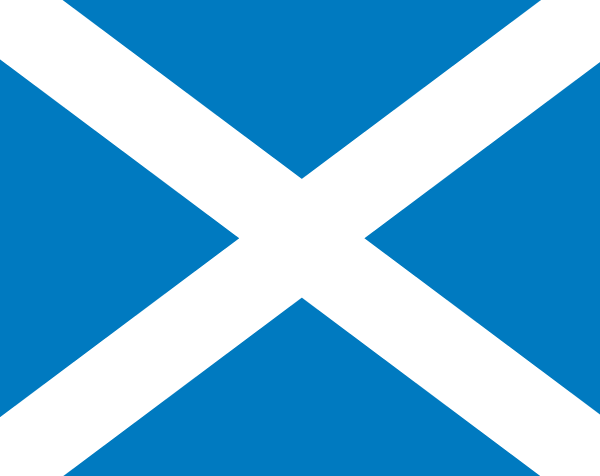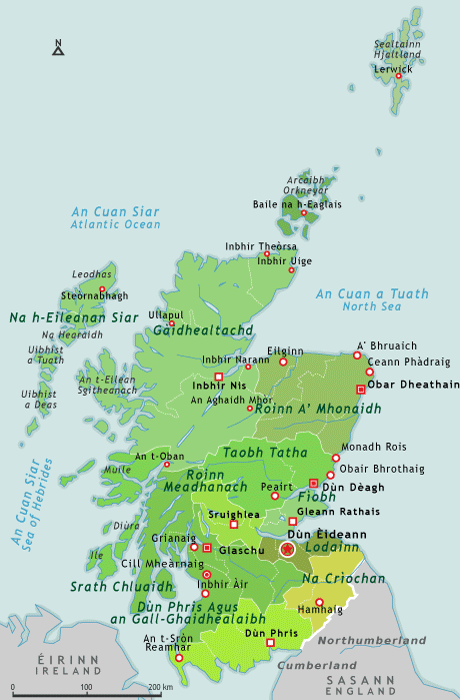Scotland, eyeing independence

Scotland is a nation situated to the north of the British Isles. Largely autonomous today, a Scottish parliament elected by universal suffrage has managed affairs since 1999. Its separatist first minister wishes to organise a referendum on self-determination.

Scotland was initially populated by the Picts and the Scots, who were most likely Celts and from whom they take their name. Scotland did not have a strong Roman presence. The emperors Hadrian and Antonius built walls across the south of the country in defence of their empire, thus minimising Roman influence. In the 10th century, Domnall II (Donald II) became the first king of the Alban kingdom extending throughout the Gaelic and Scots territory. It was in the Middle Ages that the different kingdoms making up this region united to create Scotland, while also maintaining ties with neighbouring England. Over many centuries, there were successive wars between the two states. It was not until the 14th century that England recognised the independence of its neighbour, which by then had its own parliament. Even though Scotland lost its independence in 1707, polls regularly give the figure of 35% for Scots in favour of independence.
Today, a special feature of Scotland remains its use of the minority languages, Gaelic in the north-west and Scottish in the south-east. The Scottish nation cannot therefore be defined in linguistic terms. The Scottish independence movements, born in the 1920s (inspired at that time by their Irish neighbours Sinn Féin), are trying to regain their power by maintaining a unique culture made up of symbols known around the world.

Identity card

| Name | Alba | Scottish Gaelic Scotland | Scots, English |
| Population | 5,094,800 inhab. (2005) |
| Area | 78,772 km² |
| Languages | Gàidhlig | Scottish Gaelic (official) Scots leid | Scots (official) English (official) |
| Number of native speakers | 58,400 to 92,400 | Scottish Gaelic (2001) 1,500,000 | Scots (1996) |
| State of guardianship | United Kingdom |
| Official status | Constitutive Nation of the United Kingdom with its own Parliament |
| Capital | Dùn Eideann | Scottish Gaelic Edinburgh | Scots, English |
| Historic religion | Anglican Christian and Presbyterian |
| Flag | Bratach-croise | Scottish Gaelic Saltire | Scots, English Saint Andrew’s Cross | English |
| Anthem | Flùir na h-Alba | Scottish Gaelic Flouer o Scotland | Scots Flower of Scotland | English |
| Motto | Nemo me impune lacessit | Latin Cha togar m’ fhearg gun dìoladh | Scottish Gaelic No one provokes me with impunity | English |

Timeline

- 843 • Foundation (mythical) of the kingdom of Scotland by Cinéad mac Ailpin, king of the Picts and the Gaels.
- 1314 • Battle of Bannockburn (Allt a’Bhonaich), Scottish victory of Robert Bruce against the English, Scottish independence is preserved.
- 1603 • Union of the English and Scottish crowns. The king of Scotland James VI becomes James I of England.
- 1707 • Union of the English and Scottish parliaments, disappearance of the parliament in Edinburgh.
- 1746 • Battle of Cùil Lòdair (Culloden) which marks the end of Scottish-Gaelic and the clans of the Highlands.
- 1762 • Start of the Clearances, massive emigration of the Gaels of the Highlands under pressure by land owners who were looking to replace them with sheep, which were more profitable.
- 1999 • First session of the new Scottish parliament.

Brief history

Despite the English having had their eye on the coast of Scotland since the foundation of the kingdom in 843, we denote the wars of independence as being a series of conflicts at the end of the 13th and the beginning of the 14th century. The first war began with the invasion of Scotland by England in 1296 for dynastic reasons and ended with the Edinburgh-Northampton Treaty in 1328. The victories of William Wallace and Robert Bruce (at Bannockburn) date from this war. The second war of independence (1332–57), which commenced with a new English invasion, finally saw the Scottish troops venture into England. In both cases, Scotland’s fate as an independent nation was strengthened. The Arbroath Declaration (signifying the attachment of Scotland to its independence) was signed by the Scottish nobles during the first war in 1320. It remains a reference today.

Geography

Scotland occupies the northern third of the island of Great Britain. Principally a mountainous area, the highest mountain of the island, Ben Nevis (Beinn Nibheis), in the Grampian Channel is found there, which stands at 1,344m. The country is made up of some 790 islands, of which only 10% are habitable, and 3,680 km of coastline. Among the larger islands are found Mull, Islay, Skye, Lewis, Juda to the west and the islands of Shetland and Orkney to the north. The country is traditionally divided into the Highlands and Lowlands and mountainous zones in the south (Southern Uplands). The maximal distance from north to south is 443 km and the maximal distance from east to west is 248 km, although few places are in fact more than 64 km from the sea. Since 1996, the country has been divided administratively into 32 councils (represented on the map), which can take an official name in Gaelic. The principal towns are (in order): Glasgow, Edinburgh, Aberdeen, Dundee, Inverness, Stirling.



Languages

Gàidhlig / Scots
Scotland, like Brittany for example, is not bilingual but trilingual. Two languages are traditionally used besides English. One is the Gaelic language, Goidelic branch of Celtic and Scottish (also called Scots), a Germanic language similar to English. The best estimations show over 90,000 speakers of Gaelic, corresponding to only 2% of the total population. Mainly spoken in the Hebrides to the north-west of Scotland, Gaelic was made official in 2005, thanks to the re-establishment of the Scottish parliament following a referendum in 1999. Its status is equivalent to that of the Welsh. Scottish (or Scots) is spoken to a varying degree by more than a million Scots, who are often mistakenly thought to be speaking a tainted form of English. The Scottish have never had a great interest in Scots on account of their common origin with the English. Today, it is used in some schools to varying degrees. The situation could rapidly change with the current government, which is supportive of the language.

Politics now

Scotland has been a part of the United Kingdom since 1707, the year in which the country lost its parliament (even though the crowns were united in 1603). It is a parliamentary monarchy, the head of state being Queen Elizabeth II. The Scottish parliament was restored in 1999 after a referendum in 1997. It is responsible for all internal affairs in Scotland, except for reserved domains (army, foreign affairs). Parliament also has limited powers in taxation, which were not used until 2008. In the 2011 General Election, the separatist Scottish National Party dramatically won an overall majority of seats in the Scottish Parliament. Its leader, first minister Alex Salmond, has pledged to hold a referendum on Scottish independence during his current term of office.
The most representative Scottish nationalist parties
- Scottish National Party (SNP) (Progressive separatist; in power since 2007)
- Scottish Socialist Party (SSP) (Separatist)
- Scottish Green Party (Separatist ecologist)

